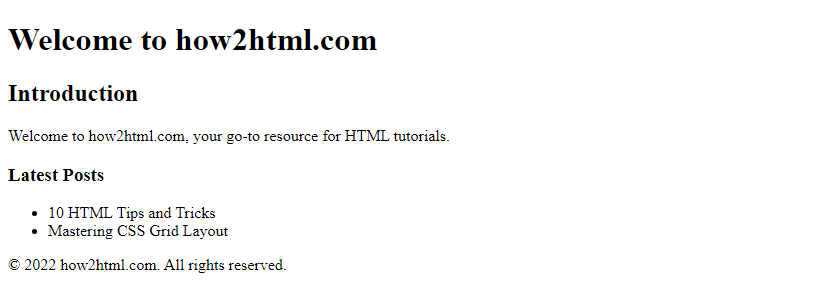HTML Layout
When building a website, the layout is key to making sure the content is well-organized and visually appealing. HTML provides various ways to structure and design the layout of a webpage. In this article, we will explore different HTML layout elements and techniques to create a well-designed webpage.
1. Basic Layout Structure
HTML uses elements such as <header>, <footer>, <nav>, <section>, <article>, and <aside> to create a basic layout structure for a webpage. These elements help organize the content and improve the readability of the page.
Output:

2. Creating Columns
HTML also allows you to create columns within a webpage using the <div> element along with CSS styling. This is useful for organizing content into multiple sections side by side.
Output:

3. Responsive Design
With the growth of mobile devices, responsive design has become essential for web development. Using CSS media queries, you can create a layout that adapts to different screen sizes.
Output:

4. Grid Layout
CSS Grid Layout is a powerful tool for creating complex layouts with rows and columns. It allows for precise control over the placement of elements within a grid container.
Output:

5. Flexbox Layout
Flexbox is another layout mode in CSS that provides a more efficient way to distribute space and align items within a container. It is especially useful for creating dynamic layouts that can adapt to different screen sizes.
Output:

6. CSS Frameworks
CSS frameworks like Bootstrap and Foundation provide pre-built components and layouts to help developers create responsive and visually appealing websites quickly. These frameworks offer a grid system, typography, forms, buttons, and more.
Output:

7. Table Layout
Tables are another way to organize content in HTML, although they are not recommended for layout purposes. However, tables can be useful for displaying data in rows and columns.
Output:

8. Semantic HTML5 Elements
HTML5 introduced new semantic elements like <header>, <footer>, <section>, <article>, and <aside> that provide more meaning to the content. Using these elements helps improve SEO and accessibility.
Output:

9. Accessibility and Usability
When designing a layout, it is important to consider accessibility and usability. Make sure to use proper heading structure, alt text for images, and descriptive links to improve the overall user experience.
Output:

10. SEO Optimization
In addition to accessibility considerations, it is important to optimize the layout and content of a webpage for search engines. Use proper heading tags, meta descriptions, and alt text to improve the SEO of your website.
Output:

Conclusion
In conclusion, HTML provides a variety of layout elements and techniques to help you create well-structured and visually appealing webpages. Whether you’re using basic layout elements like <header> and <footer>, or more advanced techniques like CSS Grid Layout and Flexbox, it’s important to consider the user experience, accessibility, and SEO when designing your website layout. By mastering these HTML layout concepts, you can build a professional and engaging website for your users.
Remember, the key to a successful layout is to keep it simple, organized, and user-friendly. Experiment with different layout techniques and find what works best for your content and audience. Happy coding!
 How HTML
How HTML